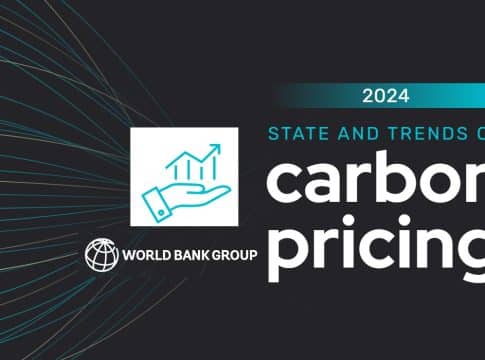Carbon Pricing Revenues Hit Record $104B in 2023, World Bank
A World Bank report reveals that countries with carbon pricing mechanisms generated a record $104 billion in revenues last year. Over half of the funds were directed towards climate and nature-related programs.
Carbon pricing, implemented through carbon taxes or emissions trading systems (ETS), is critical for reducing emissions and fostering low-emission growth.
Despite this achievement, the report emphasizes that current carbon taxes and emissions trading schemes remain insufficient to meet the Paris Agreement’s climate goals. Although 24% of global emissions are covered by some form of carbon pricing, less than 1% are subject to prices high enough to limit temperature increases to below 2°C.
The High-Level Commission on Carbon Prices recommended carbon prices be in the $50-100 per ton range by 2030. Adjusted for inflation, this range is now $63-127 per ton.
The World Bank stresses the need for increased coverage and higher pricing to drive significant reductions in global emissions and support the transition to a low-carbon economy. Here are the key takeaways from the WB’s “State and Trends of Carbon Pricing 2024.”
Increasing Uptake of Middle-Income Countries But Carbon Prices Remain Insufficient
Over the past year, the adoption of carbon pricing has been limited, but there are promising signs of uptake in middle-income nations.
Currently, there are 75 carbon taxes and emissions trading schemes in operation worldwide, reflecting a net gain of two carbon pricing instruments over the past 12 months. Notably, middle-income countries such as Brazil, India, and Turkey have made significant progress towards implementing carbon pricing mechanisms.
RELEVANT: Carbon Pricing Surge Sparks Climate Finance Boom with $100B Raise
Progress has also been seen at the subnational level, despite some setbacks. Additionally, sector-specific multilateral initiatives for international aviation and shipping have advanced.
These developments indicate a growing global commitment to addressing climate change through economic incentives.
Despite a decade of strong growth, carbon prices remain insufficient. There exists a notable implementation gap between countries’ commitments and the policies they have put into place.
Currently, carbon pricing instruments cover around 24% of global emissions. While the consideration of new carbon taxes and emissions trading systems (ETSs) could potentially increase this coverage to almost 30%, achieving this will require strong political commitment.
Over the past year, carbon tax rates have seen slight increases; however, price changes within ETSs have been mixed, with 10 systems experiencing price decreases, including long-standing ETSs in the European Union, New Zealand, and the Republic of Korea. As a result, current price levels continue to fall short of the ambition needed to achieve the goals of the Paris Agreement.
Carbon Pricing Hit New Highs
In 2023, carbon pricing revenues reached new highs, exceeding USD 100 billion for the first time. This milestone was driven by high prices in the EU and a temporary shift in some German ETS revenues from 2022 to 2023.
ETS continued to account for the majority of these revenues. Notably, over half of the collected revenue was allocated to funding climate- and nature-related programs. Despite this record-breaking revenue, the overall contribution of carbon pricing to national budgets remains low.
On a positive note, emerging flexible designs and approaches reflect the adaptability of carbon pricing to national circumstances.
Governments are increasingly employing multiple carbon pricing instruments in parallel to expand both coverage and price levels. While carbon pricing has traditionally been applied in the power and industrial sectors, it is now being increasingly considered for other sectors such as maritime transport and waste management.
Additionally, governments continue to permit regulated entities to use carbon credits to offset carbon pricing liabilities, enhancing flexibility, reducing compliance costs, and extending the carbon price signal to uncovered sectors. Beyond mitigation, carbon pricing also provides significant fiscal benefits, further demonstrating its multifaceted advantages.
Carbon Credit Markets Saw Mixed Movements: ET vs. OTC
Governments, particularly in middle-income countries, are increasingly incorporating crediting frameworks into their policy to support both compliance and voluntary carbon markets. Despite this, credit issuances fell for the second consecutive year, and retirements remained substantially below issuances, resulting in a growing pool of non-retired credits in the market.
While compliance demand is building, voluntary demand continues to dominate. Prices declined across most project categories, with the exception of carbon removal projects, which saw increased interest.
Prices also proved more resilient in over-the-counter transactions, where buyers can pursue specific purchasing strategies. Credits with specific attributes—such as co-benefits, corresponding adjustments, or recent vintages—traded at a premium, highlighting the additional value these characteristics offer to buyers.
Restoring the Integrity of Carbon Credits
The subdued market and reduced confidence underscore the importance of initiatives aimed at rebuilding the integrity and credibility of carbon credits. The integrity of these credits remains a critical concern for the market.
To address this, the Integrity Council for the Voluntary Carbon Market has established a benchmark for credit quality, with the first tranche of approved credits anticipated in 2024. On the demand side, efforts have been directed towards emphasizing the reduction of operational and value chain emissions and exploring the potential role of carbon credits in addressing residual emissions.
Additionally, the development and implementation of Paris Agreement Article 6 continues, despite facing setbacks and delays. These efforts are essential to restoring confidence and ensuring the effectiveness of carbon credit markets.
The post Carbon Pricing Revenues Hit Record $104B in 2023, World Bank appeared first on Carbon Credits.



